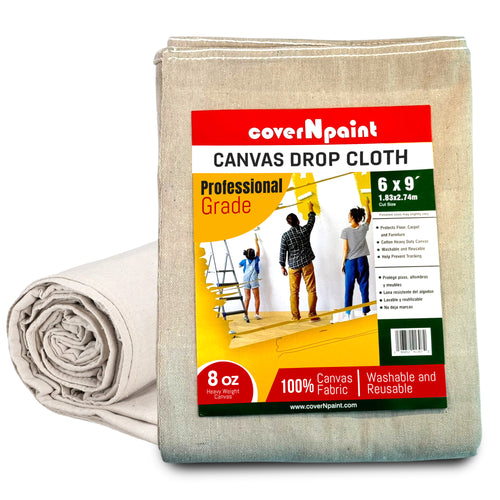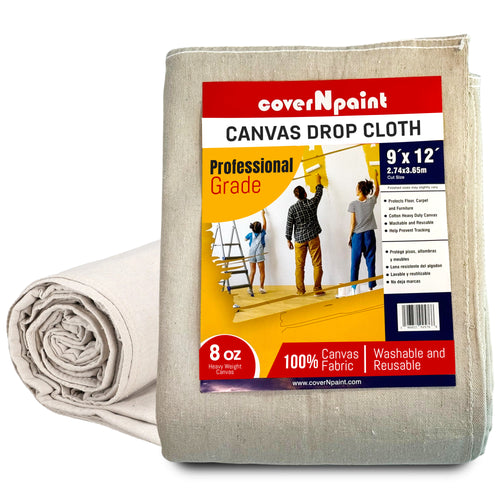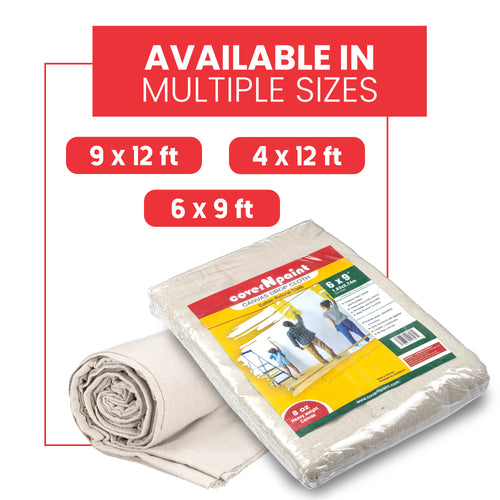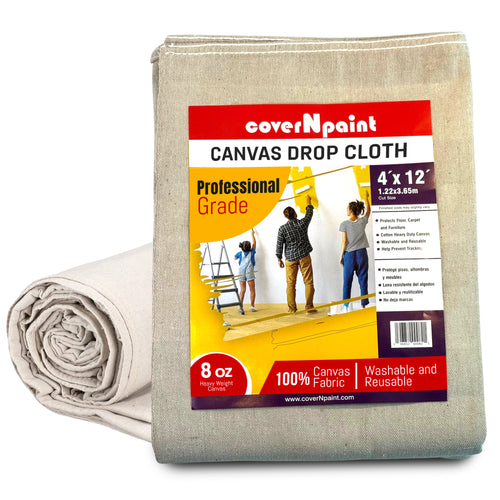Painting can completely transform a home, room, or furniture piece—but without proper surface protection, it can also lead to costly messes. That’s why paint tarps, also known as painters drop cloths, are essential for both professionals and DIY enthusiasts.
This guide covers everything you need to know about paint tarps—from their types and uses to the key benefits that make them a must-have for any painting project. By the end, you’ll understand how to select the right drop cloths and how they contribute to a safer, cleaner, and more efficient painting process.
What Are Paint Tarps?
Paint tarps are large protective coverings designed to shield floors, furniture, and other surfaces from paint spills, drips, and splatters. While commonly called painters drop cloths or paint drop cloths, the term “tarp” emphasizes their heavy-duty and versatile nature.
They come in various materials—canvas, plastic, paper-backed, or hybrid fabrics—and are used not only in painting but also in construction, renovation, and DIY projects.
Types Of Paint Tarps
Choosing the right paint tarp depends on your project type, environment, and budget. Below are the most common types:
1. Canvas Drop Cloths
-
Durable & Reusable: Canvas is the traditional and most trusted material for drop cloths.
-
Absorbent: It soaks up paint drips, preventing them from spreading.
-
Non-Slip: Provides a safer walking surface than plastic tarps.
-
Eco-Friendly: Washable and reusable, making it sustainable.
Canvas remains the go-to choice for professionals who need long-lasting protection.
2. Plastic Paint Tarps
-
Waterproof: Ideal for preventing liquids from soaking through.
-
Disposable: Inexpensive and designed for one-time use.
-
Lightweight: Easy to spread over furniture and walls.
Best for small DIY projects or when cost is the main priority.
3. Paper-Backed Tarps
-
Absorbent Top Layer: Controls drips and splatters.
-
Plastic Bottom Layer: Ensures no leakage reaches the floor.
-
Cost-Effective: Good balance between reusability and affordability.
These are particularly useful for quick touch-ups or indoor projects.
4. Poly-Backed Canvas Tarps
-
Hybrid Protection: Combines the durability of canvas with the waterproofing of poly.
-
Slip Resistant: Safer for high-traffic work areas.
-
Reusable: Designed for multiple painting sessions.
Ideal for both professional contractors and DIYers who want added protection without losing reusability.
Common Uses Of Paint Tarps
Protecting Floors And Carpets
Paint drips on wood, tile, or carpet can be difficult to remove. Painters drop cloths provide a reliable barrier that absorbs or blocks paint.
Covering Furniture And Fixtures
Large canvas drop cloths or plastic tarps can be draped over furniture, cabinets, or countertops to protect them during painting.
Outdoor Projects
When painting fences, exterior walls, or decks, tarps shield surrounding areas like lawns, driveways, and patios.
Dust And Debris Control
Beyond painting, paint tarps are commonly used during sanding, remodeling, or moving to prevent dust and debris from spreading.
Crafting And DIY Projects
Creative homeowners repurpose canvas drop cloths for curtains, table covers, or crafting projects, showing the versatility of these materials.
Benefits Of Using Paint Tarps
1. Maximum Surface Protection
Prevents permanent damage to flooring, furniture, and other surfaces.
2. Cost Efficiency
A one-time investment in a canvas drop cloth can save thousands in repair or cleaning costs.
3. Safety And Stability
Canvas tarps are less slippery than plastic, reducing accidents. For additional tips on preventing injuries, read our detailed guide: Painters Drop Cloth Safety Guide: Preventing Slips, Trips, and Falls.
4. Reusability And Eco-Friendliness
Canvas and poly-backed tarps can be washed and reused, reducing waste compared to disposable plastic sheets.
5. Professional Appearance
Using proper tarps ensures a cleaner jobsite, leaving a positive impression on clients or guests.
Choosing The Right Paint Tarp
When selecting a paint tarp, consider the following:
-
Project Size: Larger rooms require bigger tarps or multiple cloths.
-
Surface Type: Canvas for carpets and floors, plastic for furniture, and hybrids for multipurpose use.
-
Frequency Of Use: Invest in canvas if you paint regularly; choose plastic if it’s a one-time project.
-
Budget: Disposable tarps are cheaper upfront, but canvas offers long-term savings.
Expert Tips For Using Paint Tarps Effectively
-
Secure The Edges: Use painter’s tape to keep tarps in place and avoid slips.
-
Layer For Heavy Jobs: For maximum protection, layer plastic beneath canvas.
-
Clean After Use: Shake off dust and wash canvas tarps to extend their lifespan.
-
Store Properly: Fold neatly and store in a dry place to prevent mold.
-
Inspect Regularly: Check for holes or fraying before each use.
A Curiosity-Building Note
While paint tarps may seem like simple tools, their evolution from basic canvas sheets to modern hybrid materials reveals just how essential they are. Even small changes in how you clean, fold, or layer a canvas drop cloth can significantly extend its lifespan. coverNpaint USA continues to highlight these expert insights so both professionals and DIY painters can make the most of their tools.
Benefits Of Knowing About Paint Tarps
-
Better Decision-Making: Choose the right material for your project.
-
Improved Safety: Avoid slips and falls with the right tarp type.
-
Environmental Impact: Understand how reusing drop cloths supports eco-friendly practices.
-
Cost Savings: Prevent expensive flooring or furniture repairs.
FAQs
Q1: What is the difference between paint tarps and painters drop cloths?
They are often used interchangeably. A paint tarp usually refers to heavier or waterproof protection, while a canvas drop cloth is the traditional reusable option.
Q2: Can canvas paint tarps be washed?
Yes. Use a gentle cycle with cold water and mild detergent. Always air dry to maintain strength.
Q3: Are plastic paint tarps reusable?
Lightweight ones are usually disposable, but heavy-duty plastic tarps can be reused if cleaned properly.
Q4: How do I keep paint tarps from slipping?
Secure edges with painter’s tape or use slip-resistant poly-backed canvas tarps.
Q5: What size paint tarp should I buy?
For rooms, 9x12 ft tarps are standard. Smaller sizes are best for furniture, while larger ones cover whole floors.













